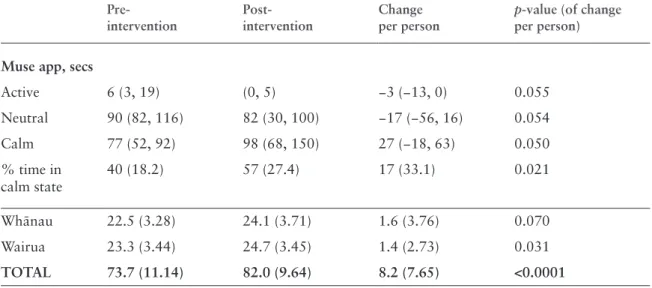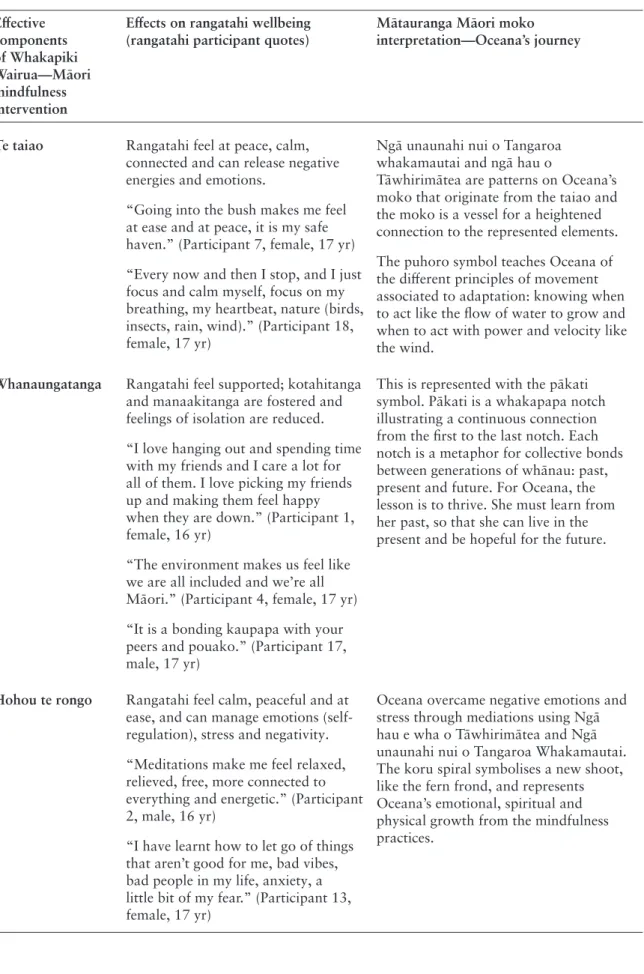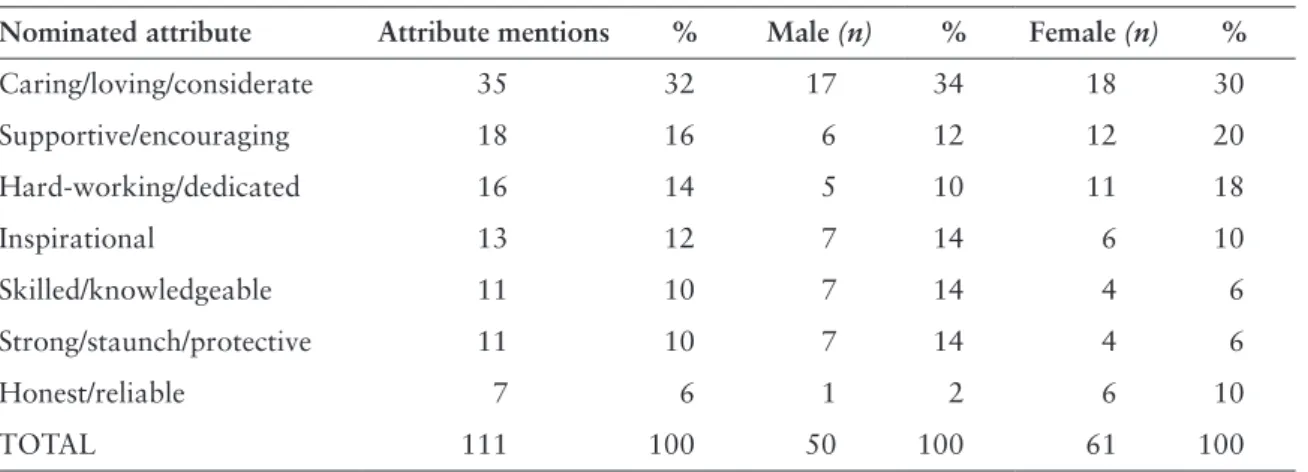Mahi toi—The importance of creativity is reflected in the saying “I orea te tuatara ka batuta ki waho”. Manaaki Tāngata - The Secret of Happiness: Stories from Older Māori in the Bay of Plenty [PhD Thesis, University of Auckland].
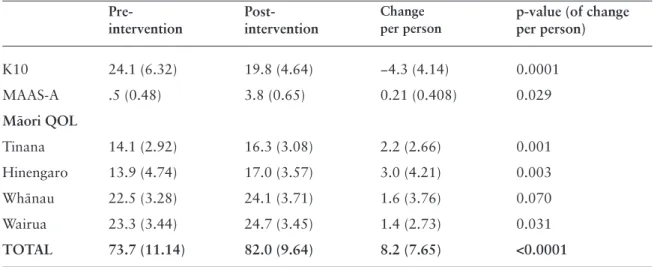
TAPU AND NOA AS NEGOTIATORS OF MĀORI GENDER ROLES IN PRECOLONIAL
AOTEAROA AND TODAY
In pōwhiri there is the karanga, which Mikaere (2016) explains is the initial process through which the whakanoa of the manuhiri takes place. Woman was formed in the image of man, and the seed of life came from Io-matangaro.
MEASURING WHANAUNGATANGA AND IDENTITY FOR WELL-BEING
IN RANGATAHI MĀORI
Research in education has particularly highlighted the benefits of a positive Māori cultural identity promoting rangatahi well-being (Rata Webber, 2012; Webber et al., 2020). Māori cultural embeddedness”, or “the degree and intensity of cultural identification” and predicted well-being and adaptive coping over time in a stratified random sample of rangatahi Māori (N.

NGĀ KARE Ā-ROTO O NGĀ KAIPUPURI WHENUA
Ko te raru o te riri ko etahi o nga Kaitiaki Whenua ka tere te tuku moni kino. Kei te mamae tonu te tangata i te motu o o ratou hononga ki te whenua.
THE VOICES OF KAUMĀTUA DURING THE COVID-19 PANDEMIC
A key aspect of their stories is how their community came together through a project that arose out of the lockdown called "Feed the Pā". The research team knew it was important to let the voice of the kaumātua they were researching be heard. In addition, two members of the research team traveled to Rotorua to provide additional support.
Although not the primary focus of the video recordings, Feed the Pā was an important topic for the kaumātua. They described how it brought together the community around Para te Hoata (Tūnohopū) Marae, one of the marae in Ohinemutu village. Others joined Tuatini and the irāmutu, including one of the other kaumātua who participated in the videos, Vicki Mae Bhana.
They were not passive recipients of the care packages from the Feed the Pā project, but active in their creation and implementation.
MAIRANGITIA TE ANGITŪ
Role models in the extended family are of great cultural, emotional and social importance to Ngāpuhi students. The Ngāpuhi students spoke of their hopes of making their role models proud of them. Some of the Ngāpuhi students planned to pursue careers that matched what their role models were doing.
The current study found that Ngāpuhi High School students' role models play a central role in their motivation to persist in school. Overall, the Ngāpuhi students' responses indicate that they have multiple role models in their lives. Role models served multiple functions as they influenced the school goals and aspirations of the Ngāpuhi students in this study.
How role models influence the motivation and goals of role aspirants [PhD dissertation, University of Exeter].

ONCE WERE NAVIGATORS
He referred to the five navigation markers—Te Rapunga, Te Kitenga, Te Whāinga, Te Whiwhinga and Te Rawenga—in the context of using the environmental factors to determine the direction of travel. For the purposes of this research, the term Te Arahina is used to refer to the process of the five navigation markers. In the context of Te Arahina, hina is also the personification of the moon (māhina is one of the words for moon in te reo Māori).
The first phase of the Te Arahina process, Te Rapunga, is the starting phase of the research journey. Williams & New Zealand Advisory Committee on the Teaching of the Maori Language, p. 326) and rapunga is defined by Moorfield (n.d.-c) as a "search, hunt, survey, investigation". In connection with this research, I adapt the phase Te Rapunga to the process of examining the current status of the research and determining the direction towards the goal.
The power is in the mind of the decision maker, and there is always an alternative path.

MĀRAKAI AS SITES OF AHI KAA AND RESISTANCE
Following the development of the Ngāti Tāwhirikura Aspirations Framework in 2012 (Ngāti Tāwhirikura Hapū A Trust, 2013), Te Moeone mārakai was developed as a means of pursuing the aspirations articulated in the framework. In this context, mārakai was an act of resistance to the conflict of Treaty settlement negotiations and a declaration of continued occupation of whenua. Visiting different areas of the mārakai allowed participants to engage in kōrero and share memories and experiences of being in and working in the mārakai.
Narrative links were inserted between verbatim quotations to clarify and expand the story of the mārakai. Hapū participants knew parts of the stories of their hapū and reflected on the effects of colonization and settlement. The connections and collaborations activated through mārakai are part of the hapū story of revitalization, beginning with uncovering the embers of ahi kaa and reclaiming whenua.
KO MARAKAI HEI PA O AHI KAA ME TE WHAKAARO 157 te hari o nga tamariki.
NGĀ TAONGA MŌHIOTANGA
The understanding of mana is therefore critical to an understanding of the Māori person or child, and the Māori world. The gathering of pūrākau of kaumātua and education leaders was the focus of the first phase of Te Whakapūmautia te Mana: Enhancing Mana through Kaitiakitanga, a two-year project funded by the Teaching and Learning Research Initiative. Many of the kaumātua and education leaders grew up with one or both grandparents living with them.
The above themes from the kaumātua's pūrākau and educational leaders were analyzed in terms of what theoretical guidance they offer for ECE teaching practice and pedagogy in relation to kaitiakitanga, which increases mana and well-being. Pūrākau gathered in the first phase of the project highlight a number of theoretical understandings central to learning to be a kaitiaki and acquisition of mana, including the need for mokopuna to have opportunities to experience and engage with their worlds, develop knowledge and understandings of their world. worlds, develop connection to and affinity with their worlds, and contribute to their worlds in meaningful ways. The pūrākau of kaumātua and educational leaders collected in phase 1 of the project were shared with kaiako and whānau in the second and third phases of the research as a basis for discussions and possible future planning.
Bijdragen Tāwhirimatea god van de elementen te ao Māori de Māori-wereld te reo Māori Māori-taal.
TŪ MANAWA ORA, TŪ MANAWA TOA
While Colenso (1881) relates this struggle to the earliest traditions of the kūmara plantation known as Pōhutukawa. Tūmatauenga returned to battle with Akerautangi in the form of the taiaha and was victorious (T. Williams, personal communication, August 28, 2018). A common outcome in Māori communities of the oppression of Māori culture and identity is the internalization of unworthiness compared to other Māori who appear knowledgeable and confident in te ao Māori.
Māori men have also been portrayed as meek and subservient, or determined and dysfunctional, including popular caricatures of the simple comedian, the natural athlete, the political activist and the romanticized traditionalist (Rua, 2015). Often coming from broken homes and surrounded by drugs, abuse, alcohol and crime, Māori youth culture was that of gangs, with little knowledge of tikanga Māori (Nakhid & Shorter, 2014). Many of the methods for relearning traditional male roles are believed to lie within Maori culture (Hokowhitu, 2007).
Tāne Māhuta gud for skoven tane Māori Māori mandlige tane ora Māori mænds sundhed.
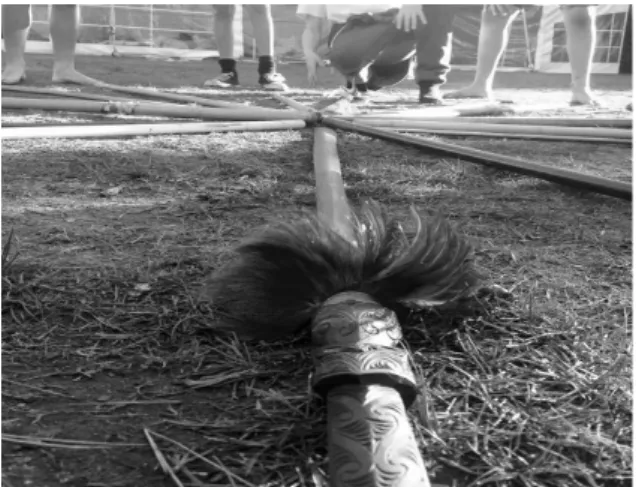
RESEARCHER POSITIONALITY AS SELF-REFLEXIVITY IN INDIGENOUS
ENTREPRENEURSHIP RESEARCH
Instead of saying, “you have to belong to the same indigenous community to do research with them.” I maintain that we [the English] are the best race in the world, and that the more of the world we inhabit, the better it is for the human race. At the end of World War II, the British monarch began the process of.
Thus, this research must be culturally sensitive, benefit both the researcher and the researched, and recognize the legitimacy of the participants. As an Indigenous person, I felt that I was part of the research, inseparable from the participants, and as Kovach (2009) suggested that Indigenous researchers should do, I was committed to relational responsibility to the participants. Henry (2017) emphasized the need to understand the cultural context of the Indigenous people included in the study.
Applying Memmi's theory of the colonizer and the colonized to the conflicts in Zimbabwe.
WHATUORA
Whatu is a body of knowledge contained within mātauranga Māori – a modern term for a body or continuum of knowledge of Polynesian origin (Royal, 2011). Royal (2011) argues that we do not need to defend or justify mātauranga Māori – “it just is what it is”. In Aotearoa, Māori academics are theorizing mātauranga Māori in new and innovative ways in research.
Ko te tukunga iho o te auahatanga, te urutau me te whakaaro whakaaro, i te wa e mau tonu ana enei maataapono matua o te matauranga Maori, ka waiho hei tauira mo te kaupapa ako a te Maori mo te whatu hei tikanga Whatuora (H. Smith, 2019). Ka tohe ahau ki konei ina hono te matauranga Māori (te mohio-pehea) ki te ariā kaupapa Māori (te kaha enabling), ka taea te whakakore i te tikanga kaupapa Māori. Na te kaupapa here kaupapa Māori, ka oho ake te matauranga hou e whai hua ana ki te whakatika i o tatou ahuatanga o naianei i roto i nga punaha matauranga o te matauranga Māori – he ture whakaatea i te whenua i mahia i waenga i nga iwi taketake o te ao.
Mātauranga Māori is a rich body of knowledge that contains embodied insights that may be greater than we can currently understand.
TACKLING SYSTEMIC RACISM IN ACADEMIC PROMOTION PROCESSES
Maori and Pacific scholars, however, often prioritize the findings and disseminate them to the communities in which they conduct their research. Racism in peer-reviewed journal processes can also affect the likelihood of Māori and Pacific academics being published. Māori and Pacific academics are best at peer-reviewing the work of Māori and Pacific scholars.
Actively monitor inequalities in the promotion, retention and recruitment of Māori and Pacific academics and set clear targets to redress them. Have promotion criteria designed at a national level by Māori and Pacific researchers and applied across all universities. Link national funding to the proportion of Māori and Pacific academics within universities, including professorships.
Glass ceilings in New Zealand universities: Inequalities in Māori and Pacific promotions or earnings.
RACE-BASED HATE CRIME IN AOTEAROA
For the relatively new policy and legislation, implementation issues remain between Netsafe and New Zealand police. The United Nations Human Rights Council's periodic review of New Zealand's human rights performance in May 2019 also recommended that the police collect data on hate crimes. As a signatory to the Declaration on Human Rights Defenders, the New Zealand government is obliged to take all necessary measures to ensure protection against any violence, threats, retaliation, adverse discrimination, pressure or any other arbitrary action as a result of the legitimate exercise of indigenous rights.
The New Zealand Bill of Rights Act 1990 states that "everyone has the right to be free from discrimination" (s19). As described in the historical overview, racism is embedded in New Zealand's settler colonial structures. In 2019, the United Nations recommended that New Zealand develop and implement a national action plan against racial discrimination, xenophobia and hate crime (United Nations Human Rights Council, 2019).
Submissions by the Islamic Women's Council of New Zealand (IWCNZ) to the Royal Commission of Inquiry into the attack on the Christchurch mosques on 15 March 2019.
